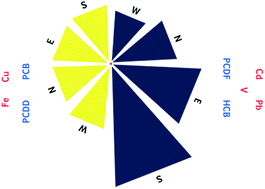Tracing the sources of PCDD/Fs in Baltic Sea air by using metals as source markers†
Abstract
The atmosphere is the major contributor of polychlorinated dibenzo-p-dioxins and dibenzofurans (PCDD/Fs) in the Baltic Sea environment. In this study, we investigated the potential of using metals along with PCDD/Fs as markers of important emission sources of PCDD/Fs in air. The air concentrations of PCDD/F congeners (n = 17), other persistent organic pollutants (n = 8) and metals (n = 16) were determined in summer and winter air using high volume samplers at a rural field station (Aspvreten, Sweden) located close to the Baltic Sea coast. During winter, PCDD/F levels were on average 20 times higher than in summer (5.1 ± 5.8 fg toxicity equivalents (TEQ) m−3 and 0.26 ± 0.18 fg TEQ m−3, respectively) mostly due to a higher fraction of PCDFs. The increased levels of PCDD/Fs were pronounced mainly in air masses that had travelled from southern (S) and eastern (E) compass sectors. A principal component analysis (PCA) of metal levels in Scots pine (Pinus sylvestris) needles sampled to reflect various air emission source types helped to identify potential marker metals for selected known atmospheric emission sources of PCDD/Fs and to rank among the candidate source types. Brown coal burning, domestic burning and heavy oil burning appeared to be the source types that contribute most of the PCDD/Fs in Baltic Sea air. The current study demonstrates a successful approach for source tracing of PCDD/Fs in air, where integrated indices from seasonal and spatial patterns of PCDD/Fs as well as metal source markers were used to trace and rank sources.



 Please wait while we load your content...
Please wait while we load your content...